
Click the map for a key to the other subspecies
|
This snake is recognized as Thamnophis sirtalis infernalis in many sources,
but the State of California treats it as a unique taxa. |
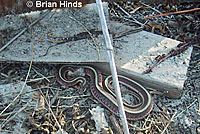 |
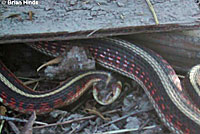 |
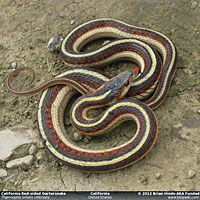 |
| Adult, Riverside County © Brian Hinds |
Adult, © Brian Hinds |
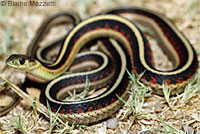 |
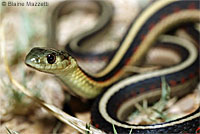 |
You can see another picture of this snake at this link to the online version of the California Amphibian and Reptile Species of Special Concern book (Thomas et al. 2016) pp. 292-295 - Common Garter Snake,
Southern Populations. |
| Adult, San Diego County © Blaine Mazzetti |
|
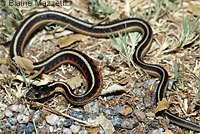 |
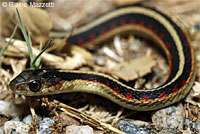 |
 |
| Juvenile, San Diego County © Blaine Mazzetti |
This Common Gartersnake was photographed in the Ventura River drainage in Ventura County which is at the edge of the range for the South Coast Gartersnake shown in the California Department of Fish and Wildlife range map (which I show on my map) so it could be this subspecies or a Valley Gartersnake. © Laurie Van Stee |
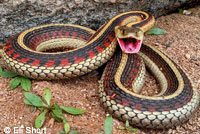 |
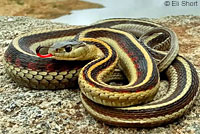 |
|
| Adult, San Diego County © Eli Short |
|
| |
|
|
| Habitat |
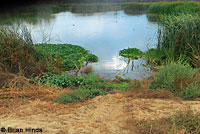 |
 |
|
| Habitat, Riverside County © Brian Hinds |
Historical habitat of the South Coast form, San Diego County
|
|
| |
|
|
|
Description |
You can read a description of this snake and see a good distribution map in the online version of the California Amphibian and Reptile Species of Special Concern book (Thomas et al. 2016) pp. 292-295 - Common Garter Snake, Southern Populations. Since very little is known about this subspecies, their description is based on the species T. sirtalis.
Also see the description for T. s. infernalis - California Red-sided Gartersnake |
There is little information available regarding what, if any, physical characteristics make this snake different from
T. s. infernalis - California Red-sided Gartersnake, or from T. s. fitchi - Valley Gartersnake. From the few pictures I have seen, the South Coast Gartersnake appears to have little or no red coloring on the head, compared to the California Red-sided Gartersnake which has a lot of red on the head. It seems to have more red on the sides than the Valley Gartersnake.
The Orange County snake shown in the book mentioned above also has no red on the head.
The Ventura County snake depicted above looks very much like a Valley Gartersnake because of the reduced red on the sides.
|
| Taxonomic Notes |
The State of California treats common Gartersnakes, Thamnophis sirtalis, found in Southern California from Ventura County south to the border with Mexico as a unique taxon different from T. s. infernalis - California Red-sided Gartersnake, and names them Thamnophis sirtalis ssp. - South Coast Gartersnake. This subspecies has not been formally described, so its recognition is not common in the literature.
--------------------------------------------------------------------------------------------------------------------------------------------------------------------
The State of California has designated Common Gartersnake populations along the coastal plain from Ventura County to San Diego County as a Species of Special Concern. These snakes are listed as a subspecies of Common Gartersnake -Thamnophis sirtalis, on the California Department of Fish and Wildlife's Special Animals List:
T. sirtalis ssp. - south coast gartersnake
(Coastal plain from Ventura Co. to San Diego Co., from sea level to about 850 m).
--------------------------------------------------------------------------------------------------------------------------------------------------------------------
"As a result of habitat loss, populations of T. sirtalis from Ventura to San Diego counties have disappeared from most of the historical range; they hang on at a handful of permanent wetlands and streams. This south coastal range segment is recognized as a CA Species of Special Concern; its subspecific affinities are unclear, although it has been informally referred to as "South Coast Gartersnake."
Hansen, Robert W. and Shedd, Jackson D. California Amphibians and Reptiles. (Princeton Field Guides.) Princeton University Press, 2025.
--------------------------------------------------------------------------------------------------------------------------------------------------------------------
In its 2018 Sportfishing Regulations, the California Department of Fish and Wildlife restricts the take of south coast common gartersnakes in L.A., Orange, Riverside, San Diego, and Ventura counties.
--------------------------------------------------------------------------------------------------------------------------------------------------------------------
In a report published in 1994, Jennings and Hayes list the "South Coast Garter Snake, Thamnophis sirtalis sp." as a species of special concern and describe its distribution, habitat, life history, and status:
"This California endemic is known only from scattered localities along the southern California coastal plain; apparently from the Santa Clara River Valley (Ventura County: SDSNH 4376; UCSB uncat.; S. Sweet, pers. comm.), south to the vicinity of San Pasqual (San Diego County: Klauber 1929; Figure 49). Verified sightings and museum specimens indicate that this taxon historically occurred from near sea level (Ballona Creek and Playa del Rey Marsh, Los Angeles County: Von Bloeker 1942) to ca. 832 m (Lake Henshaw, San Diego County: R. Fisher, pers. comm.)
...
The South Coast garter snake appears restricted to marsh and upland habitats near permanent water that have good strips of riparian vegetation (Grinnell and Grinnell 1907; S. Sweet, pers. comm.), probably because such sites provide the right combination of prey and refuge sites. Historical records of this taxon also exist for meadow-like habitats adjacent to marshlands (Van Bloeker 1942). Data are lacking on the microhabitats required for bearing young.
Status: Endangered; of the 24 known historic localities for this taxon, 18 (75%) no longer support snakes. Extensive urbanization and flood control projects have destroyed most sites; some more isolated locations, such as in the Santa Monica Mountains, appear to have lost snakes following heavy floods or extended droughts (DeLisle et al. 1986). Habitat loss through agriculture, urbanization, and flood control projects, as well as the presence of many introduced aquatic predators threatens the six remaining localities where this snake still exists. This taxon can be notorious difficult to find in some areas (Klauber 1929; S. Sweet, pers. comm.)."
(Jennings, Mark R.
and Marc P. Hayes. Amphibian and Reptile Species of Special Concern in California. California Department of Fish and Game, published November 1, 1994.)
--------------------------------------------------------------------------------------------------------------------------------------------------------------------
In a 2016 publication on herp species of special concern in California, Thompson et al discuss the South Coast Gartersnake, showing it as:
Garter Snake, Southern Populations, Thamnophis sirtalis (Linnaeus 1758). They remark that southern coastal populations of T. sirtalis have not been formally described as a distinct taxon, mentioning some ongoing studies on them, and discuss the snake's life history, taxonomy, the nature and degree of threat to it, and more.
(Robert C. Thomson, Amber N. Wright, and H. Bradley Shaffer. California Amphibian and Reptile Species of Special Concern. University of California Press, 2016.)
--------------------------------------------------------------------------------------------------------------------------------------------------------------------
"Jones et al. (2023, Journal of Biogeography 50: 2012–2029) using genome-scale data did not find support for the traditional subspecies of T. sirtalis but rather discovered four distinct geographic lineages across North America. No taxonomic suggestions were indicated."
(Nicholson, K. E. (ed.). 2025 SSAR Scientific and Standard English Names List)
--------------------------------------------------------------------------------------------------------------------------------------------------------------------
|
| Conservation Issues (Conservation Status) |
The California Department of Fish and Game lists the South Coast Gartersnake as a California Species of Special Concern. Jennings and Hayes in a 1994 publication state that 75 percent of the known historic localities for this snake no longer support snakes due to habitat loss from urbanization and flood control projects, floods, extended droughts, and introduced aquatic predators.
In California Amphibian and Reptile Species of Special Concern (2016) the authors remark that southern coastal populations of T. sirtalis have a "...very small range in a heavily-impacted part of the state. In addition, these populations have been extirpated from most of their historical range, which justifies a Priority 1 Species of Special Concern designation." The authors attribute the population decline of the taxon to habitat loss and fragmentation and natural events such as floods and droughts. They mention possible threats from introduced aquatic predators, introduced water snakes, and vegetation shifts and the availability of intermittent and ephemeral water bodies utilized by the species due to climate change.
|
|
Taxonomy |
| Family |
Colubridae |
Colubrids |
Oppel, 1811 |
| Genus |
Thamnophis |
North American Gartersnakes |
Fitzinger, 1843 |
| Species |
sirtalis |
Common Gartersnake |
(Linnaeus, 1758) |
Subspecies
|
(or possibly a full species) |
South Coast Gartersnake |
|
| Original Description |
Thamnophis sirtalis - (Linnaeus, 1758) - Syst. Nat., 10th ed., Vol. 1, p. 222
Thamnophis sirtalis infernalis - (Blainville, 1835) - Nouv. Ann. Mus. Hist. Nat. Paris, Vol. 4, p. 291, pl. 26, fig. 3
from Original Description Citations for the Reptiles and Amphibians of North America © Ellin Beltz
|
| Meaning of the Scientific Name |
Thamnophis - Greek - thamnos = shrub or bush + ophis = snake, serpent
sirtalis - Latin = like a garter - probably refers to the to striped pattern
infernalis - Latin = of hell
from Scientific and Common Names of the Reptiles and Amphibians of North America - Explained © Ellin Beltz
It is often reported that the name "garter snake" comes from the snake's striped back, which resembles the garters that were once used to hold up men's socks. In Etymology of garter snake evolutionary biologist Colin Purrington posits that "sirtalis" does not mean "like a garter" it means something closer to "ropelike." It follows that "garter snake" does not refer to the appearance of a man's garter, it is more likely "...a misspelling of guarder snake, garden snake, gardener snake, or garten snake."
|
| Other California Garternakes |
T. a. atratus - Santa Cruz Gartersnake
T. a. hydrophilus - Oregon Gartersnake
T. a. zaxanthus - Diablo Range Gartersnake
T. couchii - Sierra Gartersnake
T. gigas - Giant Gartersnake
T. e. elegans - Mountain Gartersnake
T. e. terrestris - Coast Gartersnake
T. e. vagrans - Wandering Gartersnake
T. hammondii - Two-striped Gartersnake
T. m. marcianus - Marcy's Checkered Gartersnake
T. ordinoides - Northwestern Gartersnake
T. s. fitchi - Valley Gartersnake
T. s. infernalis - California Red-sided Gartersnake
T. s. tetrataenia - San Francisco Gartersnake
|
|
|
The following conservation status listings for this animal are taken from the April 2024 State of California Special Animals List and the April 2024 Federally Listed Endangered and Threatened Animals of California list (unless indicated otherwise below.) Both lists are produced by multiple agencies every year, and sometimes more than once per year, so the conservation status listing information found below might not be from the most recent lists. To make sure you are seeing the most recent listings, go to this California Department of Fish and Wildlife web page where you can search for and download both lists:
https://www.wildlife.ca.gov/Data/CNDDB/Plants-and-Animals.
A detailed explanation of the meaning of the status listing symbols can be found at the beginning of the two lists. For quick reference, I have included them on my Special Status Information page.
If no status is listed here, the animal is not included on either list. This most likely indicates that there are no serious conservation concerns for the animal. To find out more about an animal's status you can also go to the NatureServe and IUCN websites to check their rankings.
Check the current California Department of Fish and Wildlife sport fishing regulations to find out if this animal can be legally pursued and handled or collected with possession of a current fishing license. You can also look at the summary of the sport fishing regulations as they apply only to reptiles and amphibians that has been made for this website.
Thamnophis sirtalis populations along the coastal plain from Ventura County to San Diego County are listed as a separate subspecies by the California Special Animals List - T. sirtalis pop. 1 - South Coast Gartersnake (Coastal plain from Ventura Co. to San Diego Co., from sea level to about 850 m.) with this note:
Thamnophis sirtalis pop. 1
south coast gartersnake
1) CDFW Species of Special Concern treats this population as a distinct taxon, though it is more commonly treated as a
subpopulation of Thamnophis sirtalis infernalis, the California red-sided gartersnake.
|
| Organization |
Status Listing |
Notes |
| NatureServe Global Ranking |
G5
T1T2 |
The species is: Secure.
The South Coast Gartersnake subspecies is: Critically Imperiled - Imperiled |
| NatureServe State Ranking |
S1S2 |
South Coast Gartersnake:
Critically Imperiled - Imperiled |
| U.S. Endangered Species Act (ESA) |
None |
|
| California Endangered Species Act (CESA) |
None |
|
| California Department of Fish and Wildlife |
SSC |
South Coast Gartersnake:
Species of Special Concern |
| Bureau of Land Management |
None |
|
| USDA Forest Service |
None |
|
| IUCN |
None |
|
|
|














